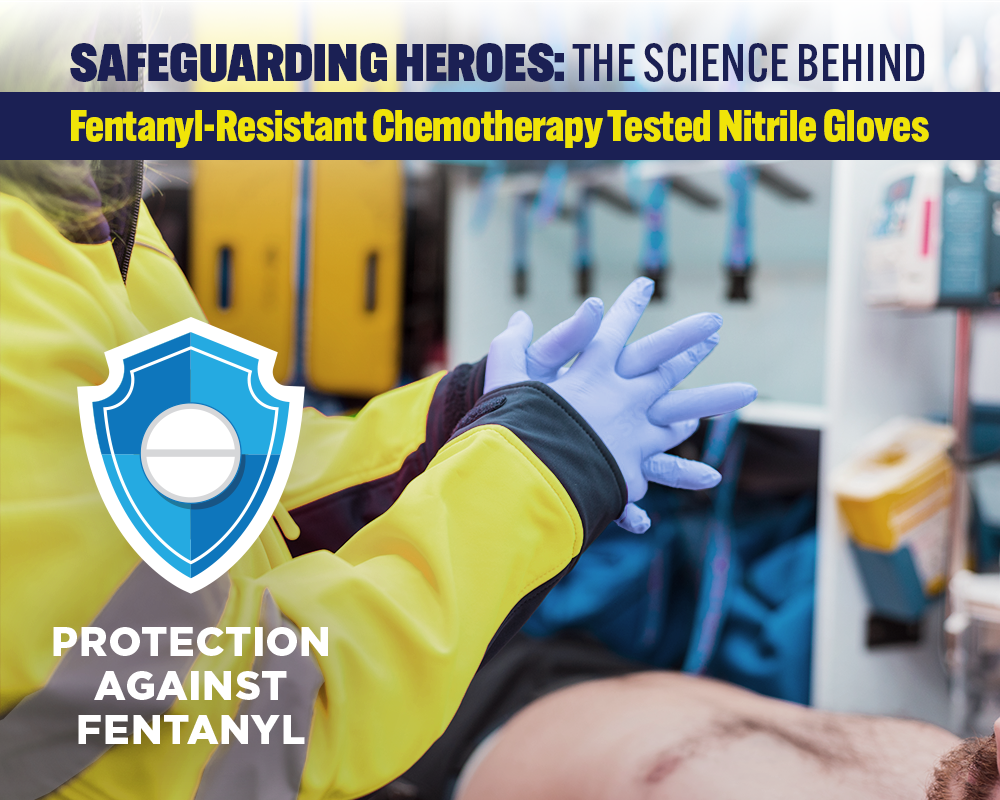Safeguarding Heroes: The Science Behind Fentanyl-Resistant Chemotherapy Tested Nitrile Gloves

Unraveling the Protective Layers for First Responders
In the unyielding battle against the fentanyl epidemic, the protection of our first responders hinges on the reliability of their gear. Within this arsenal, chemotherapy tested nitrile gloves have emerged as a formidable defense against fentanyl exposure. This article dives into the intricate processes and standards that define the fentanyl protection capabilities of these gloves.
Understanding the Fentanyl Challenge
Fentanyl, notorious for its potency, being 50-100 times more potent than morphine, and 30-50 times more potent than heroin, demands specialized protective measures. Chemotherapy tested nitrile gloves go beyond conventional options, offering a robust defense against this formidable adversary. But how are these gloves rigorously tested to ensure their efficacy?
Chemotherapy Testing Protocols: A Stringent Evaluation
The testing of chemotherapy gloves involves a series of stringent protocols to guarantee their ability to withstand exposure to hazardous substances. This includes a battery of tests specifically designed to evaluate the gloves' resistance to permeation by chemotherapy drugs, setting a high bar for their protective capabilities.
ASTM D6978-05: The Gold Standard in Fentanyl Protection Testing
One of the key standards employed for evaluating the efficacy of chemotherapy gloves against fentanyl is ASTM D6978-05. This protocol outlines a method for assessing the permeation resistance of gloves by chemicals and chemotherapy drugs. Gloves meeting this standard have demonstrated their ability to act as an effective barrier against fentanyl exposure.
Understanding Permeation Resistance
Permeation resistance is a critical parameter in determining a gloves' suitability for fentanyl protection. It measures the ability of the glove material to prevent the passage of fentanyl molecules through its surface. Chemotherapy tested nitrile gloves are engineered with a focus on high permeation resistance, ensuring that the gloves serve as an impermeable barrier against this potent opioid.
Material Composition Matters
The composition of the nitrile material plays a pivotal role in determining the gloves' protective properties. High-quality chemotherapy tested gloves are often constructed with a thicker material, enhancing their durability and resistance to permeation.
Real-world Simulations: Mimicking Exposure Scenarios
Beyond laboratory tests, real-world simulations are conducted to mimic scenarios where first responders might encounter fentanyl. These simulations provide a practical assessment of the gloves' performance in dynamic and challenging environments, ensuring their reliability in the field.
Choosing the Right Gloves for First Responders
While chemotherapy tested gloves are designed to withstand exposure to certain hazardous substances, it does not necessarily guarantee protection against fentanyl. The testing protocols for chemotherapy gloves, such as ASTM D6978-05, focus on evaluating the resistance of gloves to permeation by specific chemotherapy drugs. These drugs have unique properties, and the testing is tailored to assess the gloves' performance in the context of chemotherapy drug handling.
Fentanyl, being a synthetic opioid with high potency, may have different characteristics than chemotherapy drugs, and exposure scenarios can vary. Therefore, it's crucial to consider specific testing and standards that address fentanyl exposure when evaluating gloves for protection against this substance.
Some gloves may undergo additional testing to ensure protection against fentanyl specifically. It's essential to look for gloves that explicitly mention fentanyl resistance or have undergone testing against fentanyl according to recognized standards.
When selecting gloves for first responders who may encounter fentanyl, it's recommended to check for comprehensive testing information, including any specific certifications or standards related to fentanyl protection. Always refer to the manufacturer's specifications and certifications to ensure that the chosen gloves meet the required safety standards for fentanyl exposure.
Conclusion:
Equipping first responders with the best protective gear is not just a necessity, it's a responsibility. By choosing chemotherapy tested nitrile gloves that meet or exceed ASTM D6978-05 standards, we ensure that those on the front lines have the most advanced defense against fentanyl exposure.
In the evolving landscape of first responder safety, understanding the science behind protective gear is paramount. Chemotherapy tested nitrile gloves, proven through rigorous testing standards, stand as a testament to our commitment to safeguard those who safeguard us.
References:
ASTM International. (2005). Standard Test Method for Evaluation of Resistance to Permeation by Chemotherapy Drugs. ASTM D6978-05.
Berman, J. (2018). Fentanyl: Understanding the Risks. Journal of Emergency Medical Services.
National Institute for Occupational Safety and Health (NIOSH). (2019). Fentanyl: Preventing Occupational Exposure to Emergency Responders.
American Chemical Society. (2019). ACS Symposium Series - Fentanyl: A Comprehensive Review.
Greenawald LA, Hofacre KC, Fisher EM. Fentanyl and carfentanil permeation through commercial disposable gloves. J Occup Environ Hyg. 2020 Sep;17(9):398-407. doi: 10.1080/15459624.2020.1784426. Epub 2020 Jul 13. PMID: 32658631; PMCID: PMC10015298.





